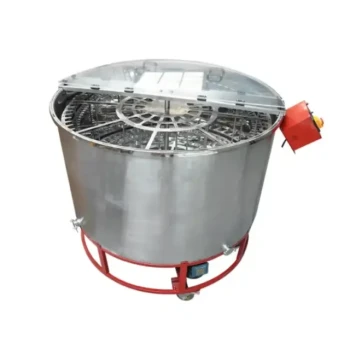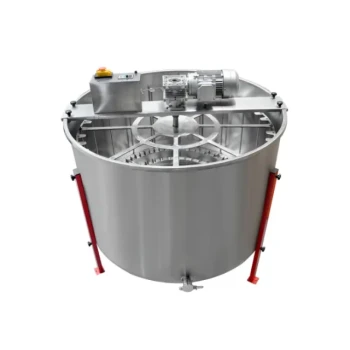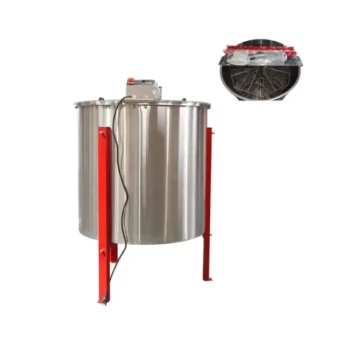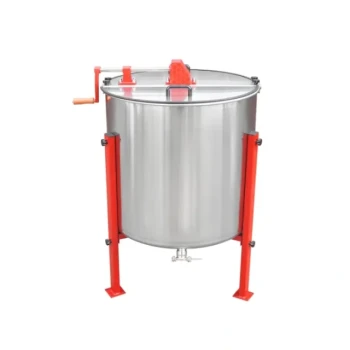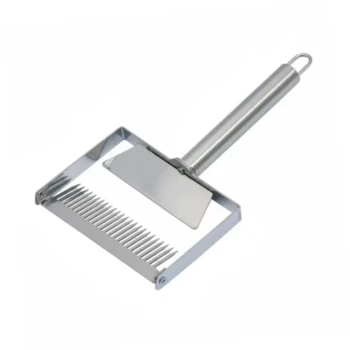At its core, the difference in capacity between electric and manual honey extractors lies in their design philosophy. Manual extractors are built for small-batch processing, typically holding between 2 and 8 frames, making them ideal for hobbyists. Electric extractors, by contrast, are engineered for throughput and are available in a wide range of sizes, from small models to large commercial units capable of handling dozens of frames at once.
The choice between a manual and an electric extractor is not just about frame capacity; it's a strategic decision balancing your financial investment against the value of your time, physical effort, and the scale of your beekeeping operation.
A Tale of Two Extractors: Manual vs. Electric
The fundamental difference in how each machine is powered dictates its ideal use case, from the backyard beekeeper to the commercial producer.
Manual Extractors: The Hobbyist's Workhorse
A manual extractor is operated by a hand crank. This simple, direct mechanism is perfect for beekeepers managing a small number of hives, typically fewer than ten.
Their capacity generally ranges from 2 to 8 frames. This limited size is matched to the lower volume of honey produced by a smaller apiary, keeping the equipment affordable and manageable.
Electric Extractors: The Engine of Productivity
Electric extractors use a motor to spin the frames, automating the most labor-intensive part of the process. This is their key advantage.
While small electric models exist, their main purpose is to increase efficiency. They are favored by commercial beekeepers or serious hobbyists who need to process honey from many hives quickly and with minimal physical strain.
Why Capacity is More Than Just Frame Count
True capacity is not just how many frames fit inside, but how quickly and easily you can process your entire harvest. This is where the operational differences become critical.
The Speed Factor: Frames per Hour
An electric motor provides consistent, high-speed rotation that a hand crank cannot match. This allows an electric extractor to remove honey from a set of frames significantly faster.
For a beekeeper with dozens of supers to process, this time savings is the most important metric. What might take a full day with a manual extractor could be completed in just a few hours with an electric model.
The Effort Equation: Your Time and Labor
Manual extraction requires significant and sustained physical effort. The process involves cranking, stopping, flipping frames, and cranking again.
An electric extractor dramatically reduces this labor. Once loaded and started, it runs independently, freeing you to perform other tasks like uncapping the next batch of frames. This transforms the workflow from a strenuous activity into an efficient, streamlined process.
The Scalability Path
Choosing an extractor is also about planning for the future. A manual extractor is an excellent starting point, but it has a practical ceiling.
If you plan to expand your apiary, an electric extractor is an investment in that growth. It provides the capacity and efficiency needed to manage an increasing number of hives without the harvest becoming an overwhelming chore.
Understanding the Core Trade-offs
Neither option is universally superior. The right choice depends on a clear-eyed assessment of the trade-offs between cost, convenience, and complexity.
Cost vs. Convenience
This is the most straightforward trade-off. Manual extractors have a much lower upfront cost, making them highly accessible for beginners.
Electric extractors are a larger financial investment. That higher price buys you speed, convenience, and reduced physical labor, which can provide a return on investment through time savings, especially in larger operations.
Simplicity vs. Power Requirement
Manual extractors are mechanically simple. With fewer moving parts, they are often easier to maintain and can be used anywhere, without needing access to electricity.
Electric models introduce a motor and control panel, adding a layer of complexity. Most importantly, they are tethered to a power source, which can be a limitation for harvesting in remote or off-grid locations.
Making the Right Choice for Your Apiary
Your decision should be guided by a realistic assessment of your current needs and future ambitions as a beekeeper.
- If your primary focus is affordability for a small apiary (fewer than 10 hives): A manual extractor is the most practical and cost-effective choice for your scale.
- If your primary focus is efficiency and time for a growing or large apiary: An electric extractor is a worthwhile investment that will scale with your operation and dramatically reduce harvesting time.
- If your primary focus is minimizing physical labor regardless of hive count: An electric model provides a significant quality-of-life improvement by automating the most strenuous part of the job.
Ultimately, the best extractor is the one that aligns your equipment with your personal beekeeping goals.
Summary Table:
| Feature | Manual Extractor | Electric Extractor |
|---|---|---|
| Typical Frame Capacity | 2 - 8 frames | Small models to dozens of frames |
| Best For | Hobbyists (<10 hives) | Commercial apiaries & serious hobbyists |
| Key Advantage | Lower cost, simplicity | Speed, efficiency, reduced labor |
| Power Requirement | Hand crank (none) | Requires electricity |
Ready to Scale Your Honey Harvesting?
Whether you're a hobbyist looking to upgrade or a commercial apiary seeking maximum efficiency, HONESTBEE has the right extractor for you. We supply high-quality beekeeping supplies and equipment directly to commercial beekeepers and distributors through wholesale-focused operations.
Let us help you choose the perfect extractor to save time, reduce labor, and boost your productivity.
Contact HONESTBEE today for a quote!
Visual Guide

Related Products
- HONESTBEE 72 Frame Industrial Electric Honey Extractor for Beekeeping
- HONESTBEE 3-Frame Manual Acrylic Honey Extractor
- Electric 8 Frame Honey Spinner Extractor Equipment for Beekeeping
- Commercial Electric 12 Frame Honey Extractor Spinner Motorized Honey Extractor
- electric honey extractor honey centrifuge 3 frame honey extractor stainless steel honey frame extractor
People Also Ask
- What should a beekeeper do after extracting honey from supers? A Guide to Harvest Management
- What is the energy consumption like for automatic honey extractors? Maximize Your Harvest Efficiency
- What are the advantages of automatic honey extractors? Scale Your Apiary with Unmatched Efficiency
- Why is preserving honeycomb integrity important, and how do automated extractors help? Boost Hive Health & Honey Yields
- What are the two common types of honey extractors? Choose the Right Extractor for Your Apiary
